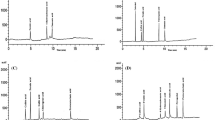Abstract
Successive extraction of the green alga, Scenedesmus acutus 276-3a with different solvents indicated that the petroleum ether extract was the most repellent to the hatched larvae of Spodoptera littoralis. The application of spray emulsified 1 % petroleum ether extract inhibited egg laying. At 0.25% concentration the moths laid only 52.4 of their egg masses on the treated oviposition sites in comparison to the untreated control. Concentration of 1% was protective against the immature stage by hindering the third instar larvae to feed on treated leaf discs. In addition, the water emulsion of petroleum ether extract was insecticidal. The percentage mortality was directly proportional to the concentration applied and to the duration of exposure.
Résumé
L’extraction successive de l’alge verte Scenedesmus acutus 276-3a avec des different solvents montre, que l’extrait du l’ether fretrole e’tait le plus reperable aux larves obtenues de Spodoptera littoralis. Des concentrations différent de l’extrait d’ether pétrole étaient examines pour la diminution ovipositionale, l’activité contre le manger et l’ecaractere insecticide contre les insectes qui attacquent les feuilles du cotton Spodoptera littoralis. Les résultats obtenus montrent que 1 % concentration de l’eau emulsifie de l’extrait de l’ether pétrole diminue le nombre des oeufs. A concentration e’gale 0,25% la mere donne seulement 52,4 de leur oeufs, sur les ovifroitions traits en comparant au control pas traites. 1% concentration agie comme une concentration protegante contre l’état pas bien developé et cela en prévenant la troisième de la larve de manger les disques des, feuilles traites. En plus l’eau emulsifie de l’extrait de l’ether pétrole était insecticide dans un pourcentage de mortalité qui est directement proportional à la concentration appliquée et la durée de l’exposition.
Similar content being viewed by others
References
Abbott, W. S. (1952) A method of computing the effectiveness of an insecticide. J. Econ. Entomol. 18, 265–267.
Allen, N. B. (1965) Excretion of organic compounds by Chlamydomonas. Arch. Microbiol. 24, 163.
Amonkar, S. V. (1969) Fresh water algae and their metabolites as a means of biological control of mosquites. Ph.D. Dissert. Department of Entomology University of California, Riverside.
Angerilli, P. D. and Beirne, B. P. (1974) Influence of some freshwater plants on the development and survival of mosquito larvae in British Columbia. Can.J.Zool. 52, 813.
Bernays, E. and Deluca, C. (1981) Insect antifeedant properties of an iridoid glycoside: Ipolanide. Experientia 37, 1289–1290.
El-Bazt, F. K., Said, M. Badr El-Din and Mohamed, S. M. (1984) The presence of antimicrobial substance in certain algae. Egypt. J. Microbiol. 20, 57–60.
Finney, D. J. (1971) Probit analysis. 3rd Edn. Cambridge University Press, London.
Gentile, G. J. (1971) In Microbial Toxins (Edited by S. Kadis, Aciegler and Ajl, A. J.), vol. 7 p. 27. Academic Press, New York.
Khalifa, A., Rizk, A., Salama, H. S. and Sharaby, A. (1973) Role of phagostimulant of cottonleaves in the feeding behaviour of Spodoptera littoralis. J. Insect. Physiol. 19, 1501.
Kubo, I. and Nakanishi, K. (1982) Host Plant Resistance to Pests (Edited by Hedin, P. A.), American Chemical Society: Washington, DC. 1977. ACS Symp. Ser. No. 62, p. 165.
Lwande, W., Hassanalli, A., Njoroge, P. W., Bentley, M. D., Delle Monache, F. and Jondiko, J. I. (1985) A new 6 a hydroxy petrocarpan with insect antifeedant and antifungal properties from the roots of Tephrosia hildebranditii. Insect Sci. Applic. 6, 537.
Rosenthaler, L. (1930) The Chemical Investigations of Plants. G. Bell and Sons, Ltd, London.
Salama, H. S. and Sharaby, A. (1980) Efficiency of algae as a protein source in diets for rearing insects. Z. angew. Entomol. 90, 329–332.
Saleh M., Abbas Nadia, M., Abdel Moein and Nagy, A. Ibrahim (1982) Insect antifeeding Azulene derivative from the brown alga Dictyota dichotoma. J. Agric. Food Chem. 32, 1432.
Author information
Authors and Affiliations
Rights and permissions
About this article
Cite this article
Sharaby, A., Salama, Z.A., El-Din, M.M. et al. Evaluation of the Insecticidal Properties of the Green Alga, Scenedesmus Acutus Against the Egyptian Cotton Leafworm Spodoptera Littoralis (Boisd). Int J Trop Insect Sci 14, 615–619 (1993). https://doi.org/10.1017/S1742758400018014
Received:
Accepted:
Published:
Issue Date:
DOI: https://doi.org/10.1017/S1742758400018014




